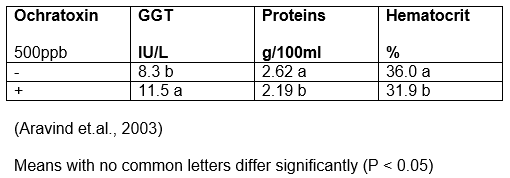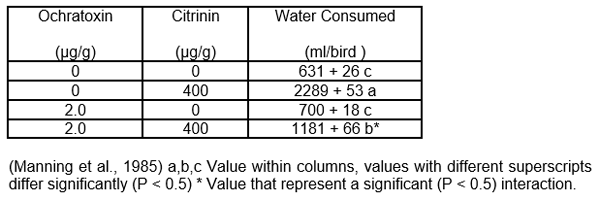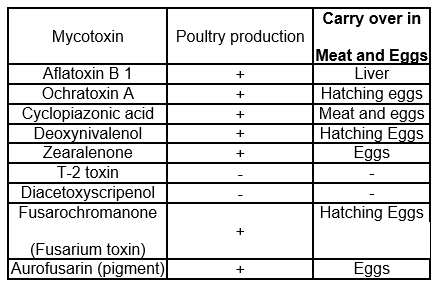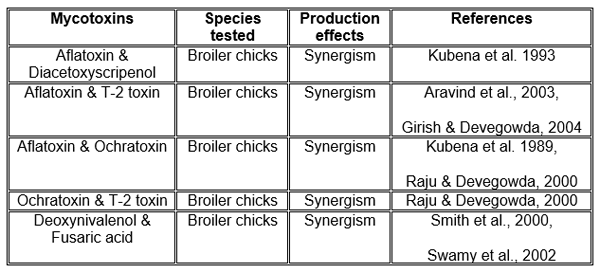Effect of Mycotoxins on Poultry Industry and Practical Solutions
Published: December 27, 2014
By: Dr. Shinde Ganesh B., Dr. Parikshit B. Biradar, Dr. M. S. Rawekar Department of Animal Nutrition, College of veterinary and Animal Sciences, Udgir, MAFSU, Nagpur, (M.S.) India.
Introduction
There has been a steady increase in the poultry meat and egg production globally during the past few decades. Though the high biological value of eggs and poultry meat have resulted in an increasing demand for these two products, growing awareness for food quality and safety are becoming increasingly significant in determining the market value. The importance of mycotoxins as one of the major detractor of poultry productivity and also of product quality, hence, becomes more relevant now than ever.
According to the United Nation’s Food and Agriculture Organization (FAO), approximately 25% of world’s grain supply is contaminated with mycotoxins. The greatest economic impact of mycotoxin contamination is felt by crop and poultry producers, as well as food and feed producers (CAST, 2003). The economic losses caused by mycotoxins in poultry run up to several hundred million dollars annually worldwide. The adverse effects of mycotoxin contaminated diets consumed by poultry on productive performance of the birds range from the undetectable to devastating by way of reduced egg production in layers and breeders, and growth depression in broilers, turkeys, ducks etc.
Mycotoxins of importance in poultry are mainly produced by the fungi genera Aspergillus, Fusarium and Penicillia, at the pre-harvest, harvest and in storage or during feed processing whenever conditions are favorable. No region of the world escapes these silent killers and their negative impact on poultry productivity and human health is enormous (Devegowda, 2001; Devegowda and Aravind, 2002).
Production of Mycotoxin Standards- First time in India
Before September 11 th 2001, mycotoxin standards were imported from USA (Sigma chemical company) for analysis of mycotoxins in the Poultry and Livestock feeds and the residues in various animal products. After September 11 th, 2001, terrorist attack and anthrax scare (bio-terrorism); the United States Government has banned export of all toxic materials including mycotoxin standards.
Keeping in mind the necessity of mycotoxin reference standards for the benefit of food and feed industry, we successfully produced Aflatoxin B1, Ochratoxin A and T-2 toxin reference mycotoxin standards under the project “production of mycotoxin standards for estimation of mycotoxins in animal feeds” funded byDepartment of Biotechnology, Govt. of India, with Prof. G. Devegowda as Principal Investigator.
The mycotoxin standards are required by:
- Poultry and Livestock industry
- Feed manufacturers
- State and Central government research institutes
- Analytical and Quality control laboratories
- Food processing industry / Food exporters
- Diagnostic laboratories
We are supplying these mycotoxin standards to the required Institutions/ Industries throughout the country on a complementary basis.
Significant mycotoxins in poultry
Some fungal strains are capable of producing more than one mycotoxin and also a single mycotoxin is produced by more than one fungus. The most important mycotoxins for poultry and the fungi producing them are given in the table 1.
Table 1. Moulds and mycotoxins Important in intensive poultry production

Impact of mycotoxins on production performance
Table 2. Effect of feeding aflatoxin contaminated diet on serum biochemical parameters in broilers at five weeks of age

Table 3. Effect of aflatoxin on broiler breeder progeny performance

Table 4. The effects of dietary ochratoxin on hematological and serum biochemical parameters

Table 5. Individual and combined effects of ochratoxin and citrinin on water consumption of broiler chickens between 2 and 3 weeks of age

Table 6. Effect of T-2 toxin on laying hen performance

Table 7. Effect of T-2 toxin on antioxidants in the quail liver, mcg/g

Table 8. Relevance of naturally occurring mycotoxins as residues in poultry products

Co-contamination of feeds by mycotoxins in poultry
Over several years considerable amount of research has been conducted into the co-occurrence of mycotoxin in feeds. Mycotoxin co-contamination can occur in many combinations, some of which are listed in Table 9. Co-contamination is a natural phenomenon, persistent in most cases than we can imagine, since the fungi that produce mycotoxins do not exist in nature as pure cultures.
Table 9. Co-contamination of mycotoxins in Poultry
- Aflatoxins and Ochratoxin
- Aflatoxins and T-2 toxin
- T-2 toxin and Diacetoxyscripenol
- Ochratoxin and Citrinin
- Vomitoxin and Fusaric acid
Table 10. Impact of co-contamination by mycotoxins in poultry

Control of the adverse effects of mycotoxins
The most effective method of neutralizing mycotoxins that are already present in feed is by binding them to an inert compound before they can be absorbed from the intestine. The question that feed manufacturers, livestock and poultry producers are asking is: “which mycotoxin binder is most effective?” The “ideal” features of good mycotoxin binder are:
- Ability to bind a wide range of mycotoxins
- Low effective inclusion rate in feed
- Rapid and uniform dispersion in the feed during mixing
- Heat stability during pelleting, extrusion, and during storage
- No affinity for vitamins, minerals or other nutrients
- High stability over a wide pH range and
- Bio-degradability after excretion
Different methods of detoxification of Mycotoxins
- Nutritional modifications
- Herbal mold inhibitors
- Chemical detoxification
- Application of mineral clays
- Natural and practical solutions
Natural and practical solutions– recent biotechnological approaches
In the early 1990s, commercially yeast culture preparation of Saccharomyces cerevisiae 1026 , which was earlier noted as a nutritional aid and a growth promoter, was found to improve hatchability (McDaniel, 1991). Further investigations lead to the establishment of yeast culture preparation’s ability to bind aflatoxins in poultry feeds (Devegowda et al., 1994, 1998a 1998b and 1998c).
This work was a landmark that signaled the beginning of a set of new strategies that use yeast-derived products to overcome problems associated with mycotoxin-contaminated feeds. Several researchers confirmatively proved that the modified glucomannan, a derivative of the yeast cell wall, is able to bind higher levels of several important mycotoxins at a lower inclusion rates as compared to the limited narrow range binding abilities of inorganic binders (Mahesh and Devegowda, 1996; Volkl and Karlovsky, 1998; and Trenholm et al., 1996). Some interesting recent research findings are listed below:
Modified glucomannan supplementation is beneficial in reducing the individual and combined adverse effects of aflatoxin, ochratoxin and T-2 toxin in broilers Apart from improving the body weights and antibody titres suppressed by combined dietary mycotoxins, modified glucomannan also improves serum biochemical and hematological parameters (Raju and Devegowda, 2000).
In a trial conducted to determine the efficacy of modified glucomannan in counteracting the toxic effects of naturally contaminated diet (aflatoxin 168ppb, ochratoxin 8.4ppb, zearalenone 54ppb and T-2 toxin 32ppb) in commercial broilers, modified glucomannan increased the performance and decreased the activity of gamma glutamyl transferase in broilers fed naturally contaminated diet ( Aravind et.al., 2003),.
Murthy and Devegowda (2004) demonstrated the rapid absorption of aflatoxin and T-2 toxin (Reddy and Devegowda, 2004) by modified glucomannan in a biological system at different time intervals after ingestion of feed in broiler chickens. They clearly showed the ability of modified glucomannan to rapidly adsorb mycotoxins within 30 minutes of feeding.
Feeding broilers with diets containing aflatoxin (2 mg/kg) and T-2 toxin (1 mg/kg), significantly reduced feed intake, weight gain and feed efficiency, weights of thymus and bursa of Fabricius, antibody titers against Newcastle disease and infectious bursal disease. Modified glucomannan (1 kg/ton of feed) significantly improved body weight, feed intake, antibody titers, weights of thymus and bursa of Fabricius suggesting action against both aflatoxin and T-2 toxin. Hydrated sodium calcium aluminosilicate (10 kg/ton of feed) showed improvement against AF without much protection against T-2 toxin (Girish and Devegowda 2004).
With dietary treatments of four concentrations of T-2 toxin (0, 0.5, 1.0, and 2.0 mg/kg) and two concentrations (0 and 0.1%) of modified glucomannan, Manoj and Devegowda (2001) observed that modified glucomannan reversed the suppression of egg production by T-2 toxin on egg production. Even at the highest concentration of T-2 toxin (2 mg/kg) wherein egg production was reduced to less than 90% of the control, modified glucomannan-restored production to more than 95% of the control.
Conclusions:
The most appropriate practices for mycotoxin control are :
- Prevention of fungal growth on crops in the field, at harvest of crop, during storage of feedstuffs and processing of feed.
- Time to think is not when production is at its lowest but at the time of purchase of raw materials, storage etc., so that mycotoxin levels can be limited to a minimum.
- Application of appropriate mycotoxin binder in order to achieve good productivity and economy.
References:
Aravind, K. L., V. S. Patil, G. Devegowda, B. Umakantha and S. P. Ganpule. 2003. Efficacy of modified glucomannan to counteract mycotoxicosis in naturally contaminated feed on performance, serum biochemical and hematological parameters in broilers. Poult. Sci. 82: 570-576.
Council for Agricultural Science and Technology (CAST). 2003. Mycotoxins: Risks in Plant, Animal, and Human Systems. Ames, Iowa, USA.
Devegowda, G., M. V. L. N. Raju, N. Afzali and H. V. L. N. Swamy, 1998a. Mycotoxin picture worldwide: Novel solutions for their counteraction. Feed Compounder, 18 (6) : 22-27.
Devegowda, G., M.V.L.N. Raju, N. Afzali and H.V.L.N. Swamy. 1998b. Mycotoxin picture worldwide: Novel solutions for their counteraction. In: Biotechnology in the Feed Industry: Proceedings of Alltech's 14 th Annual Symposium (T. P. Lyons and K.A. Jacques, eds). Nottingham University Press, Nottingham. pp. 241-255.
Devegowda, G., M.V.L.N. Raju and H.V.L.N. Swamy. 1998c. Mycotoxins: Novel solutions for their counteraction. Feedstuffs. 70 (50): 12-17.
Devegowda, G. 2001. Mycotoxins: Economic risks and their control. In: Handbook of Poultry Nutrition. (Eds. V. Ramasubba Reddy and Dinesh T. Bhosale) Published by American Soybean Association, pp. 246-260.
Devegowda, G., and K. L. Aravind. 2002. Global mycotoxins problem: Biological solutions. In: proc.150th year celebration, Institute Superior de Agronomia., Lisbon, Portugal. pp. 30-45.
Dvorska, J. E., and P. F. Surai. 2001. Effect of T-2 toxin, zeolite and mycosorb on antioxidant systems of growing quail. Asian – Aust. J. Anim. Sci. 14: 1752-1757.
Girish C. K., and G. Devegowda. 2004. Evaluation of modified glucomannan (Mycosorb) and hydrated sodium calcium aluminosilicate to ameliorate the individual and combined toxicity of aflatoxin and T-2 toxin in broiler chickens. Australian Poultry Science Symposium. Sydney. Vol (16): pp 126-129.
Kubena, L. F., R. B. Harvey, W. E. Huff, D. E. Corrier, T. D. Phillips, and G. E. Rottinghaus. 1989. Influence of ochratoxin A and T-2 toxin singly and in combination on broiler chickens. Poult. Sci. 68:867–872.
Kubena, L. F., R. B. Harvey, W. E. Huff, A. G. Yersin, M. H. Elissalde, and D. A. Witzel. 1993. Efficacy of a hydrated sodium calcium aluminosilicate to reduce the toxicity of aflatoxin and diacetoxyscirpenol. Poult.,Sci. 72(1) : 51–59.
Manoj, K. B., and G. Devegowda. 2001. Use of esterified glucomannan to reduce the effects of T-2 toxin in laying hens. In : Proc. of The World Mycotoxin Forum, The Netherlands. pp. 71.
Mahesh, B. K. and G. Devegowda, 1996. Ability of aflatoxin binders to bind aflatoxin in contaminated poultry feeds – an in vitro study. In : Proc. XX World’s Poultry Congress, New Delhi, India. 4 : 296.
Manning, R. O., T. P. Brown, R. D. Wyatt, and O. J. Fletcher. 1985. The individual and combined effects of citrinin and ochratoxin A in broiler chicks. Avian Dis 29:986–997.
McDaniel, G. 1991. Effect of Yea-Sacc 1026 on reproductive performance of broiler breeder males and females. In: Proc. Alltech’s 7 th Annual Symposium on Biotechnology in the Feed Industry. Alltech Technical Publications, Nicholasville, Kentucky, USA.
Murthy, T. N. K., and G. Devegowda. 2004. Efficacy of modified glucomannan (Mycosorb) to adsorb aflatoxin B 1 in gut conditions of broiler chickens. In: 22 nd World’s Poultry Congress, Istanbul, Turkey : pp : 471
Qureshi, M. A., J. Brake, P. B. Hamilton, W. M. Hagler, and S. Nesheim, 1998. Dietary exposure of broiler breeders to aflatoxin results in immune dysfunction in progeny chicks. Poult. Sci. 77: 812 – 819.
Raju, M. V. L. N. and G. Devegowda. 2000. Influence of modified glucomannan on performance and organ morphology, serum biochemistry and hematology in broilers exposed to individual and combined mycotoxicosis (Aflatoxin, Ochratoxin and T-2 toxin). Br. Poult. Sci. 41: 640-650.
Reddy, N. B., and G. Devegowda. 2004. Ability of modified glucomannan (Mycosorb) to sequestrate T-2 toxin in the gastrointestinal tract of chicken. Asian – Aust. J. Anim. Sci. 17(1). (Accepted for publication)
Smith, T. K., M. Modirsanei and E. J. Macdonald. 2000. The use of binding agents and amino acid supplements for dietary treatment of Fusarium mycotoxicosis. In: Biotechnology in the Feed Industry. Eds: Lyons, T. P. and Jacques, K. A., Nottingham University Press, Loughborough, Leics, UK, pp. 383-390.
Swamy H. V. L. N., T. K. Smith, P. F. Cotter, H. J. Boermans, and A. E. Seftons. 2002. Effects of feeding blends of grains naturally contaminated with Fusarium mycotoxins on production and metabolism in Broilers. Poult. Sci. 81: 966 – 975.
Trenholm, H. L., L. L. Charmley, and D. B Prelusky. 1996. Mycotoxin binding agents:
An update on what we know. In: Biotechnology in the Feed Industry Eds: Lyons. T. P and Jacques. K. A, Nottingham University Press, Loughborough, Leics, UK.
Volkl, A and P. Karlovsky. 1998. Biological detoxification of fungal toxins and its use in plant breeding, feed and food production. Natural Toxins 7: 1-23.
Related topics
Authors:
Join to be able to comment.
Once you join Engormix, you will be able to participate in all content and forums.
* Required information
Would you like to discuss another topic? Create a new post to engage with experts in the community.
Create a post20 de enero de 2015
is there any harvest technologies available which will reduce changes of getting more of mycotoxines in india?










.jpg&w=3840&q=75)